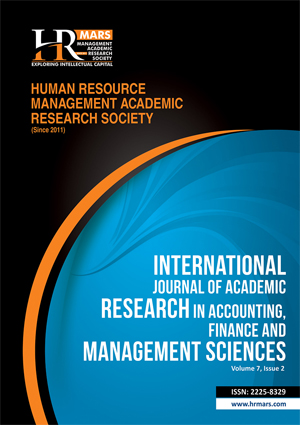
ISSN: 2225-8329
Open access
A growing number of studies have been critical of gender imbalance in microfinance practices, motivating this paper to identify the lending pattern of each type of Microfinance Institutions (Microfinance Institutions-bank, cooperatives or credit union, non-government organisations, non-bank financial institutions, rural banks and others) across six regions: Sub-Saharan Africa (SSA), East Asia and the Pacific (EAP), Eastern Europe and Central Asia (EECA), Latin America and the Caribbean (LAC), Middle East and North Africa (MENA), and South Asia (SA). By using data of 9, 982 MFI-years observations from Mix Market database, this paper shows the trend of MFIs lending in SSA, EAP, EECA, LAC, are dominating by NGOs. Interestingly, Non-bank financial institutions (NBFIs) are competing with NGOs in serving women borrowers in MENA and South Asia region.
Agier, I., Szafarz, A. (2013). Microfinance and gender: Is there a glass ceiling on loan size? World Development, 42, 165-181.
Bayai, I. Ikhide, S. (2016). Life cycle theory and financial sustainability of selected SADC microfinance institutions (MFIs). Economic Papers, 50(6), 121-132.
Becchetti, L., Conzo, P. (2013). Credit access and life satisfaction: evaluating the nonmonetary effects of micro finance. Applied Economics, 45, 1201-1217.
Chamlou, N. (2008). The Environment for Women's Entrepreneurship in the Middle East and North Africa. World Bank Publications: The World Bank.
D’Espallier, B., Guerin, I., Mersland, R. (2013). Focus On Women in Microfinance Institutions. The Journal of Development Studies, 49(5), 589-608.
Ebimobowei, A., Sophia, J. M., Wisdom, S. (2012). An Analysis of Microfinance and Poverty Reduction in Bayelsa State of Nigeria. Kuwait Chapter of Arabian Journal of Business and Management, 1(7), 38-57.
Ellis, A. N., Orlando, M. B., Boudet, A. M. M., Piras, C., Reimao, M., Cutura, J., Frickenstein, J., Perez, A., de Castro, O. (2010). Women’s Economic Opportunities in the Formal Private Sector in Latin America and the Caribbean. Inter-American Development Bank: IDB Publications.
Fatima, J. (2011). Microcredit and women’s empowerment in district Gujrat, Pakistan. Biannual Journal of Gender and Social Issues, 10(2), 9-25.
Fofana, N. B., Antonides, G., Niehof, A., Ophem, J. (2015). How microfinance empowers women in Côte d’Ivoire. Review of Economics of the Household, 13(4), 1023–1041.
Forster, S., Greene, S., Pytkowska, J. (2003). The State of Microfinance in Central and Eastern Europe and the New Independent States. Consultative Group to Assist the Poor. The World Bank Group. Washington, D. C.
Geleta, E. B. (2016). Microfinance and women's empowerment: an ethnographic inquiry. Development in Practices, 26(1), pp.91-101.
Giron, A. (2015). Women and Financialisation: Microcredit, Institutional Investors, and MFIs. Journal of Economic Issues, 49(2), 373-396.
Goodwin, S., Voola, P. (2013). Framing microfinance in Australia-gender neutral or gender blind? Australian Journal of Social Issues, 48(2), 223-239.
Hartarska, V., Nadolnyak, D. (2007). Do Regulated Microfinance Institutions Achieve Better Sustainability and Outreach? Cross-country evidence. Applied Economics, 39, 1207-122.
Hermes, N., Lensik, R. (2011). Microfinance: Its Impact, Outreach, and Sustainability. World Development, 39(6), 875-881.
Hudon, M., Traca, D. (2011). On the Efficiency Effects of Subsidies in Microfinance. World Development, 39(6), 966–973.
Jasmi, Z. S. (2021). Life-Cycle Stage Theory: The Funding Pattern of Microfinance Institutions. International Journal on Recent Trends in Business and Tourism, 5(2), 7-16.
Lott, C. E. (2009). Why Women Matter: The Story of Microcredit. Journal of Law and Commerce, 27, 219-230.
Mahjabeen, R. (2008). Microfinancing in Bangladesh: Impact on households, consumption and welfare. Journal of Policy Modelling, 30, 1083–1092.
Meyer, R. L. (2002). Track Record of Financial Institutions in Assisting the Poor in Asia. ADB Institute Research Paper, Asian Development Bank Institute.
Mosley, P. (2001). Microfinance and Poverty in Bolivia. The Journal of Development Studies, 37(4), 101-132.
Nguyen, H. T., Hollister, C. D. (2012). Microfinance in Vietnam: Advantages and disadvantages from the perspective of women participants. Social Development Issues, 34(3), 81-93.
Okesina, M. (2021). Why Does Microfinance Target Women? Empirical Evidence from Nigeria. Global Journal of Emerging Market Economies, 14(2), 246–264. https://doi.org/10.1177/09749101211040144
Oberhauser, A. M., Aladuwaka, S. (2020). Feminist Perspectives on Microfinance and Women’s Empowerment. Journal of Development Perspectives, 4(1-2), 59-78. https://doi.org/10.5325/jdevepers.4.1-2.0059
Rahman, K. M. (1999). Microfinance, wage employment and housework: A gender analysis. Development in Practice, 9(4), 424-436.
Rokhman, W. (2013). The Effect of Islamic Microfinance on Poverty Alleviation: Study in Indonesia. Economic Review – Journal of Economics and Business, 11(2), 21-30.
Strier, R. (2010). Women, poverty, and the microenterprise: Context and discourse. Gender, Work and Organization, 17(2), 195-218.
Yeboah, T., Arhin, A., Kumi, E., Owusu, L. (2015). Empowering and shaping gender relations? Contesting the microfinance-gender empowerment discourse. Development in Practice, 25(6), 895-908.
In-Text Citation: (Jasmi et al., 2022)
To Cite this Article: Jasmi, Z. S., Rahim, N. R. A., Razali, N. H. M., Dali, H. M., & Hassan, N. (2022). Does Lending Pattern of Microfinance Institutions to Women borrowers Differ Across Region. International Journal of Academic Research in Accounting Finance and Management Sciences, 12(3), 688–700.
Copyright: © 2022 The Author(s)
Published by Human Resource Management Academic Research Society (www.hrmars.com)
This article is published under the Creative Commons Attribution (CC BY 4.0) license. Anyone may reproduce, distribute, translate and create derivative works of this article (for both commercial and non-commercial purposes), subject to full attribution to the original publication and authors. The full terms of this license may be seen at: http://creativecommons.org/licences/by/4.0/legalcode